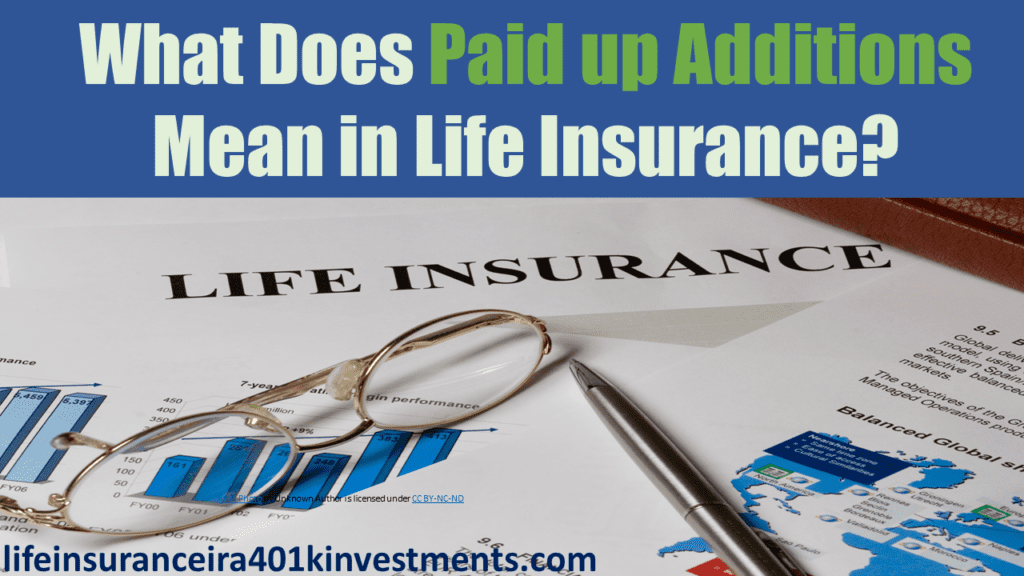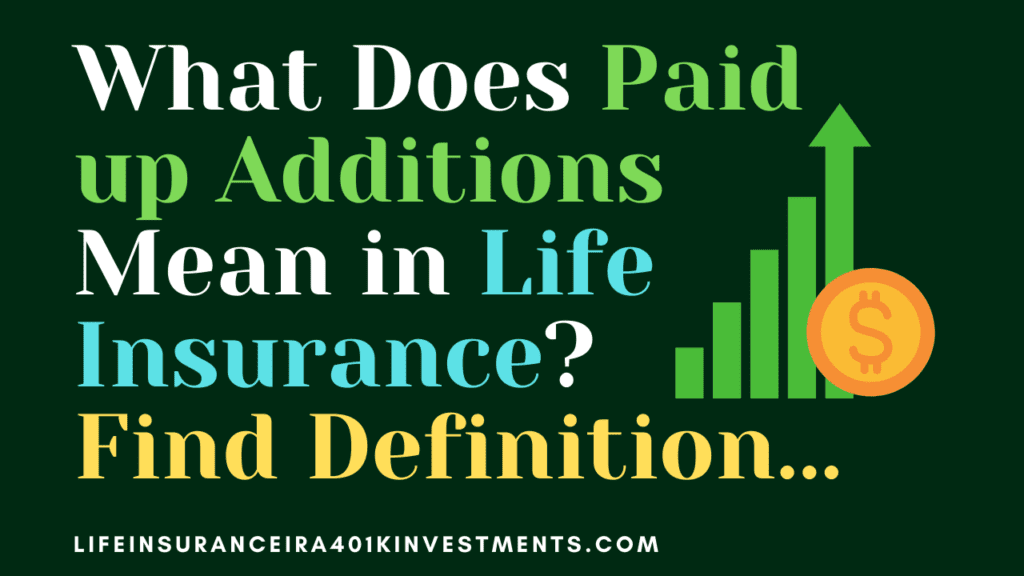Additional insurance paid is available as an additional clause in a lifetime policy. It allows the policy holder to increase their life and death benefit by increasing the cash value of the policy.

Additions paid for themselves generate dividends, and the value continues to increase indefinitely over time.
What Does Paid up Additions Mean in Life Insurance?
What Does Paid up Additions Mean in Life Insurance?
The Paid Additions Rider, or PUA Rider, has been widely spoken in books like Bank on Yourself and Infinite Banking.

What is “Paid Additions”?
Consider Additions Paid (PUA) as a single premium payment life insurance, which increases the total cash value of your policy. You can also add a special Paid Up Additions rider, an option not commonly discussed.
That also allows you to buy more using a portion of your premium payments. (your own money instead of dividend earnings), to add more coverage.
What are the benefits of adding an additional “Additional Payments” clause to your life insurance policy?
Used separately or in unison, these Paid Additions options can add significant growth to your trusted policy. Think of the concept as a savings account to which you, the policy holder.

Can contribute with personal dollars or dividends from the cheap life insurance company’s dividend growth to accelerate the cash value. Of your insurance and increase the benefit by death of the policy for his heirs.
Remember, as the policy gets bigger, your dividends could also increase. (depending on your insurance company’s annual financial performance), compounding the total cash value over time.
Paid Additions 101
Simply put, paid additions essentially mean that you are paying. In full the death benefit of your full life insurance policy. Eliminates premium payments as well as insurance costs charged by carriers.
Those same dollars your insurance used to “pay” increase the cash value of the policy and increase your death benefit.
Are paid up additions a good idea?
Paid additions are a good idea because they provide you with a higher proportion of future dividend pools.
Either way, the additional life insurance paid increases both the cash value of your policy and the permanent death benefit.
What does it mean when a policy is paid up?
Definition of ‘paid policy’
A life insurance policy in which if all premium payments are complete and the insured is free from all payment obligations.
How does a 20 pay life policy work?
A 20-payment lifetime policy is one in which you pay premiums for a maximum of 20 years. (if you die before the age of 20, the policy pays the nominal amount).
Are life insurance paid up additions taxable?
Additions paid are not taxable unlike dividends that accrue to the interests of the insurance company. The cash value of a PUA grows tax-deferred and the death benefit is tax exempt. As it is technically a miniature whole life insurance policy in itself.
What is the cash value of a 25000 life insurance policy?
The policy has no outstanding loans or prior cash withdrawals and a cumulative cash value of $ 5,000. Upon the death of the policyholder, the insurance company pays the total death benefit of $ 25,000.

Paid Additions are a Tool to Increase Value
The first thing to understand is that the paid additions feature is only available. On full life insurance policies issued as “participating” policies.
A participating policy is an insurance contract that pays dividends. (generated from the insurance company’s annual earnings) to the policy owner.
The better your insurance company performs financially, the more dividends you will get. You will take advantage of these earnings (or not) every year during the term of the policy, or much earlier. Simply put, with the cash paid out of the dividend, you buy paid additions.
Your financial advisor might characterize it as reinvested dividends.
Paid Up Additions
You can only use the Paid Up Additions tool with dividend-paying Whole Life, where you can siphon off those profits to buy it. Making a dollar-for-dollar increase to the overall value of your policy.
Of course, there are no guarantees that you will see dividend growth every year. But the more cash value your policy has, the more funds you will have to draw on for living expenses. That’s the key: more to live on while you’re still alive.
The other types of permanent life insurance: Universal Life (UL), Indexed Universal Life (IUL). And Variable Universal Life (VUL) insurance policies do not offer the additional payment option.
Neither does term life insurance, although it is much cheaper to buy and provides coverage for the time you need it most. However it does not provide an investment component.
Using Personal Dollars to Buy Paid Additions
Using dividends to buy Paid Additions is not the only game in town. And this is a lesser known but important option that you should understand.
This PUA Rider is added for an additional fee when purchasing your life insurance policy.
This option can further enrich your policy. As it literally “deposits” more cash into the policy to help it grow faster.
How do rich people use whole life insurance?
Heirs can use the proceeds of a large life insurance policy to pay a tax bill for those wealthy individuals.
Whose properties exceed the inheritance tax exemption threshold. Insurance premiums will also not be subject to inheritance taxes.
What is paid up additions face amount?
Additional insurance paid is available as an additional clause in a lifetime policy. It allows the policy holder to increase their life and death benefit by increasing the cash value of the policy.
Additions paid for themselves generate dividends, and the value continues to increase indefinitely over time.
An Example Showing the Use of Paid Additions
A 50-year-old buys a $ 300,000 death benefit with an annual base premium of $ 5,000. The owner of this policy elects to pay an additional $ 5,000. In an additional clause added in the first year.
This will add an immediate cash value of $ 5,000. As well as an additional $ 25,000 to your death benefit.
If you continue like this, you will continually increase both the value and the benefit of your policy over time.
Flexibility or Not?
You have options when it comes to the type of Paid Addition Riders you can choose from. And one provides more flexibility than the other.
- Paid Tier Addition Riders
- Riders of Flexible Paid Additions
Paid Tier Addition Riders
It is restrict it to a specific number of annual additions that you must commit to purchasing. This amount cannot vary, with some exceptions where it can be adjusted downwards. That stiffness could be a problem for some.
In contrast, the Supplemental Flexible Payments clauses provide policyholders with a range of clause funds. To choose from (depending on the insurance company) and may vary from year to year.
Investment advisers can tell their clients to opt for the flexible type of add-on clause because it allows you. Not the insurance company, to control your budget up or down.
It would be wise to ask detailed questions before purchasing a Paid Addendum Addendum. This is to ensure what you are getting: The Tier or the Flexible. Not all companies offer both.
Dividend Payout Additions and Clients can be a complex concept to fully understand. So you should weigh the pros and cons carefully, or perhaps on the advice of your Financial Advisor.
Before deciding if this is a smart choice. of “investment” for you. It was purely a tax-free death benefit product for his heirs.
Paid-Up Additional Insurance Definition
The commitment to pay the policy premiums for life can be discouraging or unaffordable for some policy owners. If you are forced to lose the policy because you can no longer keep payments. And the cash value has not risen to expectations. You could suffer a financial loss.
- Guaranteed Cash Value Vs. Net Cash Value Life Insurance.
- How to Determine the Face Value of a Life Insurance Policy.
- Do I Pay Life Insurance Surrender Charges?
Your policy’s cash value may grow enough over time that you can simply use a portion of that cash value, or future dividends. To finance your premium, keeping your policy current, while you no longer pay a penny of his pocket .
Knowledge is power when it comes to permanent life insurance. Not all policies are created the same way. And if you decide that an additional clause on payments is a critical investment component for you. Speak to one of our expert life insurance agents for guidance.
Do you need more information and professional consultation? Fill out our contact form or visit our Cheap Life Insurance Quotes. Page to see how we can help you find the cheapest life insurance policy.
How to Convert to Paid Status?
Most people buy a full life insurance policy with the best intentions, but over time the premiums can become quite difficult to pay. Or the policy may not be a worthwhile investment for much longer.
That said, letting your policy expire is never a good idea, especially after you’ve paid. For several years and accumulated cash value. This is where you may be wondering if there is a way to keep your policy. Current without continuing to pay premiums.
Fortunately, this may be an option for you, but only if your policy allows for conversion to payment status. While this means you don’t have to pay more premiums. Technically you still have to pay to keep the policy in place.
The paid life insurance policy allows you to keep your full life insurance policy. Current without continuing to pay premiums, but it is only an option if you have accumulated substantial cash value on your policy.
To simplify this, it basically means that your policy stays current by deducting premiums from your cash value account. While this means that there are no more temporary (or permanent) payments. It also means that your death benefit also decreases.
What is paid-up value in life insurance policy?
Instead, pay a death benefit based on a single lump sum purchase price. Generally, these policies increase in value as the policy ages and the value in the account earns interest.
If you die within your policy period, then your family will continue to receive your death benefit. But only the amount remaining after your premiums have been paid.
Therefore, if you choose to take the alternative route and turn in your policy or apply for a loan. This will also reduce the amount of funds available to you.
What Does Paid up Additions Mean in Life Insurance? Learn More Here.